Critical Analysis of 'Nursing Management of Aggression' Article
VerifiedAdded on 2020/05/28
|10
|2369
|203
Report
AI Summary
This report offers a critical analysis of the research paper titled "Nursing management of aggression in a Singapore emergency department: A qualitative study" by Tan, Lopez & Cleary (2015). The analysis examines various aspects of the study, including the clarity of the title, literature review, theoretical framework, sampling and recruitment methods, data collection and analysis techniques, ethical considerations, and overall study significance. The report identifies strengths, such as the use of authentic sources and a clear theoretical framework, while also pointing out weaknesses, such as the lack of gender balance in the sample, potential biases in data analysis, and insufficient detail on ethical considerations. The analysis highlights the need for a more comprehensive approach to understanding and managing aggression in the emergency department, considering factors like nurse experience, gender, and environmental influences. The report concludes with suggestions for improving future research in this area, emphasizing the importance of diverse samples, rigorous data analysis, and detailed ethical considerations.
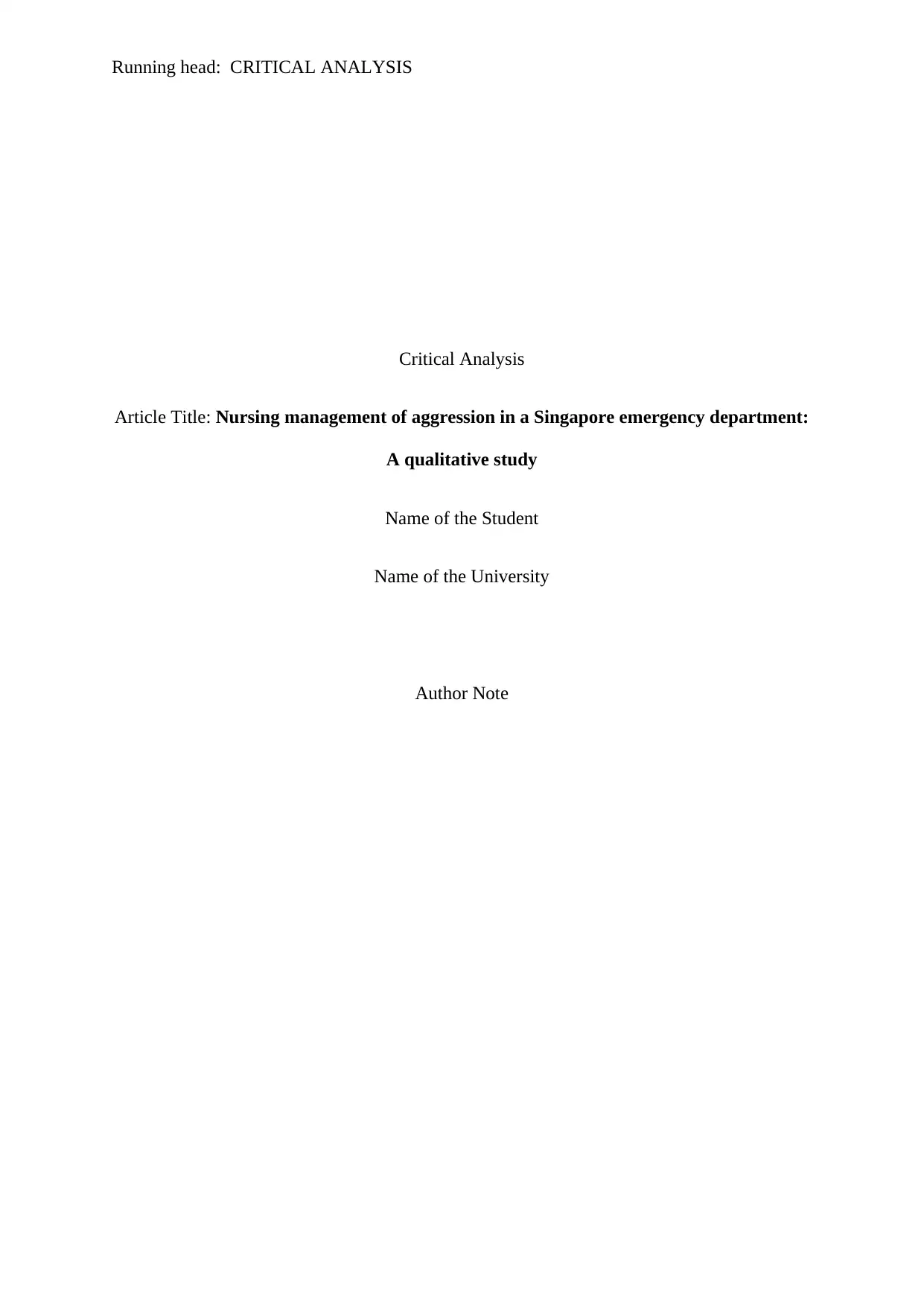
Running head: CRITICAL ANALYSIS
Critical Analysis
Article Title: Nursing management of aggression in a Singapore emergency department:
A qualitative study
Name of the Student
Name of the University
Author Note
Critical Analysis
Article Title: Nursing management of aggression in a Singapore emergency department:
A qualitative study
Name of the Student
Name of the University
Author Note
Paraphrase This Document
Need a fresh take? Get an instant paraphrase of this document with our AI Paraphraser
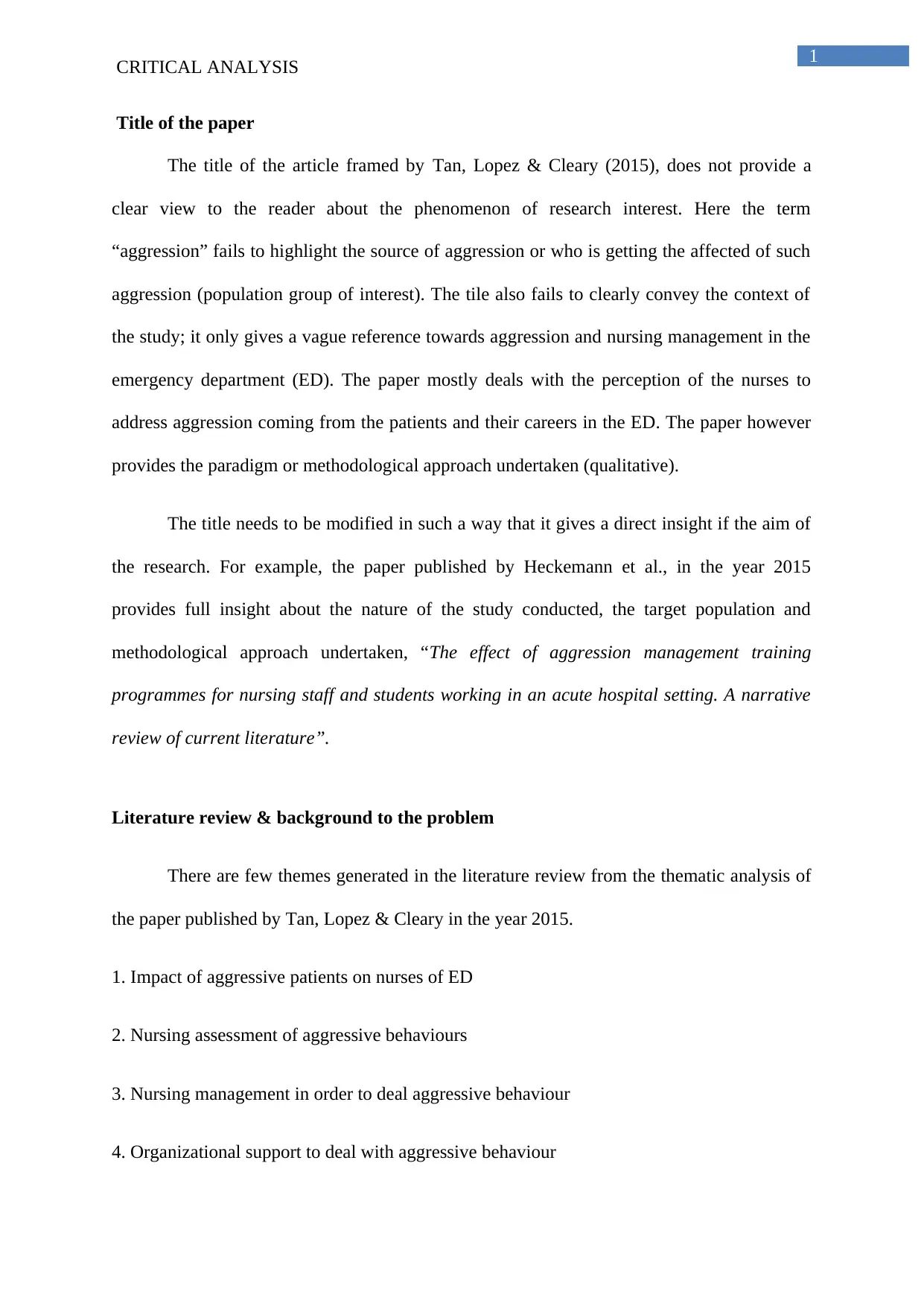
1
CRITICAL ANALYSIS
Title of the paper
The title of the article framed by Tan, Lopez & Cleary (2015), does not provide a
clear view to the reader about the phenomenon of research interest. Here the term
“aggression” fails to highlight the source of aggression or who is getting the affected of such
aggression (population group of interest). The tile also fails to clearly convey the context of
the study; it only gives a vague reference towards aggression and nursing management in the
emergency department (ED). The paper mostly deals with the perception of the nurses to
address aggression coming from the patients and their careers in the ED. The paper however
provides the paradigm or methodological approach undertaken (qualitative).
The title needs to be modified in such a way that it gives a direct insight if the aim of
the research. For example, the paper published by Heckemann et al., in the year 2015
provides full insight about the nature of the study conducted, the target population and
methodological approach undertaken, “The effect of aggression management training
programmes for nursing staff and students working in an acute hospital setting. A narrative
review of current literature”.
Literature review & background to the problem
There are few themes generated in the literature review from the thematic analysis of
the paper published by Tan, Lopez & Cleary in the year 2015.
1. Impact of aggressive patients on nurses of ED
2. Nursing assessment of aggressive behaviours
3. Nursing management in order to deal aggressive behaviour
4. Organizational support to deal with aggressive behaviour
CRITICAL ANALYSIS
Title of the paper
The title of the article framed by Tan, Lopez & Cleary (2015), does not provide a
clear view to the reader about the phenomenon of research interest. Here the term
“aggression” fails to highlight the source of aggression or who is getting the affected of such
aggression (population group of interest). The tile also fails to clearly convey the context of
the study; it only gives a vague reference towards aggression and nursing management in the
emergency department (ED). The paper mostly deals with the perception of the nurses to
address aggression coming from the patients and their careers in the ED. The paper however
provides the paradigm or methodological approach undertaken (qualitative).
The title needs to be modified in such a way that it gives a direct insight if the aim of
the research. For example, the paper published by Heckemann et al., in the year 2015
provides full insight about the nature of the study conducted, the target population and
methodological approach undertaken, “The effect of aggression management training
programmes for nursing staff and students working in an acute hospital setting. A narrative
review of current literature”.
Literature review & background to the problem
There are few themes generated in the literature review from the thematic analysis of
the paper published by Tan, Lopez & Cleary in the year 2015.
1. Impact of aggressive patients on nurses of ED
2. Nursing assessment of aggressive behaviours
3. Nursing management in order to deal aggressive behaviour
4. Organizational support to deal with aggressive behaviour
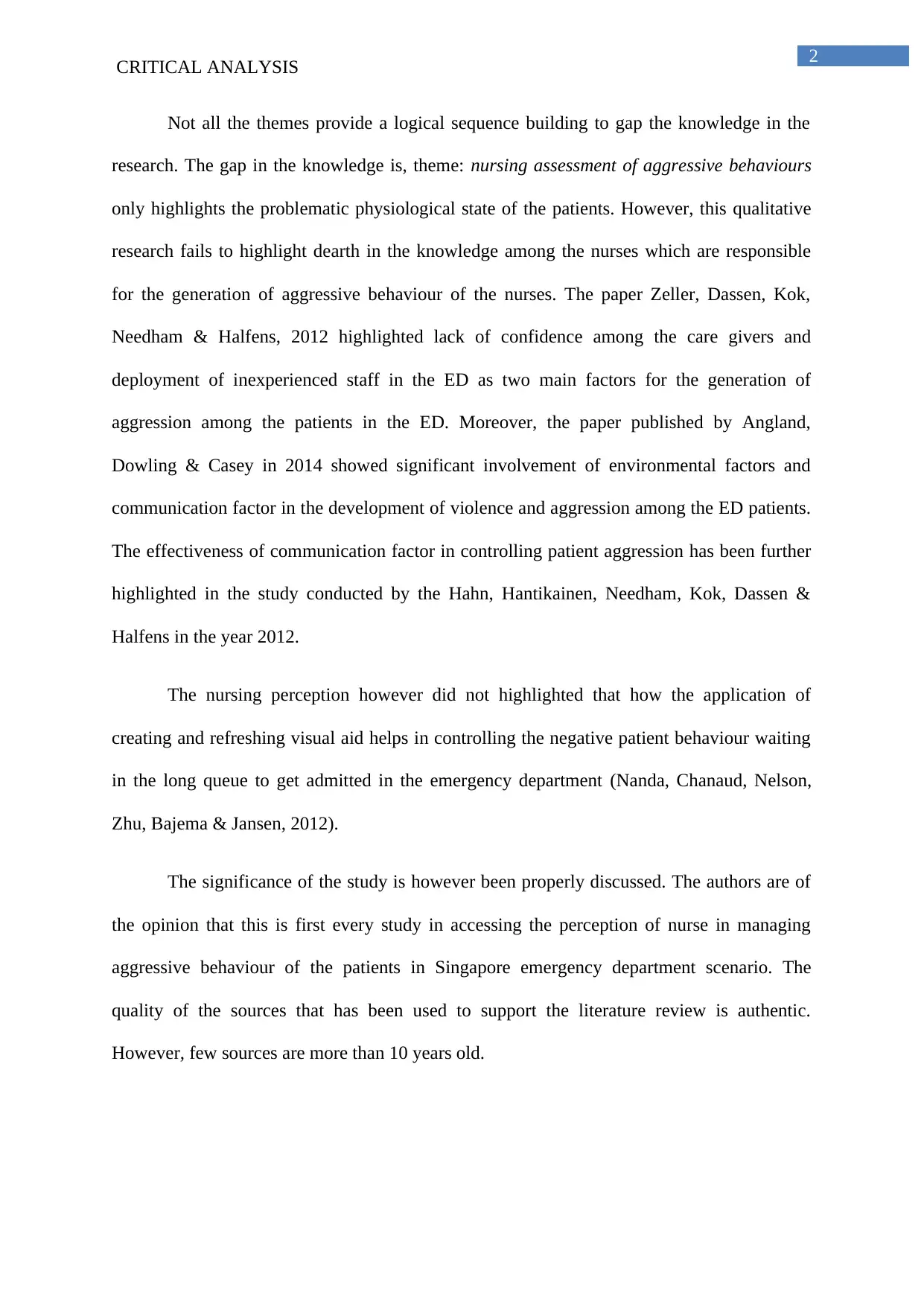
2
CRITICAL ANALYSIS
Not all the themes provide a logical sequence building to gap the knowledge in the
research. The gap in the knowledge is, theme: nursing assessment of aggressive behaviours
only highlights the problematic physiological state of the patients. However, this qualitative
research fails to highlight dearth in the knowledge among the nurses which are responsible
for the generation of aggressive behaviour of the nurses. The paper Zeller, Dassen, Kok,
Needham & Halfens, 2012 highlighted lack of confidence among the care givers and
deployment of inexperienced staff in the ED as two main factors for the generation of
aggression among the patients in the ED. Moreover, the paper published by Angland,
Dowling & Casey in 2014 showed significant involvement of environmental factors and
communication factor in the development of violence and aggression among the ED patients.
The effectiveness of communication factor in controlling patient aggression has been further
highlighted in the study conducted by the Hahn, Hantikainen, Needham, Kok, Dassen &
Halfens in the year 2012.
The nursing perception however did not highlighted that how the application of
creating and refreshing visual aid helps in controlling the negative patient behaviour waiting
in the long queue to get admitted in the emergency department (Nanda, Chanaud, Nelson,
Zhu, Bajema & Jansen, 2012).
The significance of the study is however been properly discussed. The authors are of
the opinion that this is first every study in accessing the perception of nurse in managing
aggressive behaviour of the patients in Singapore emergency department scenario. The
quality of the sources that has been used to support the literature review is authentic.
However, few sources are more than 10 years old.
CRITICAL ANALYSIS
Not all the themes provide a logical sequence building to gap the knowledge in the
research. The gap in the knowledge is, theme: nursing assessment of aggressive behaviours
only highlights the problematic physiological state of the patients. However, this qualitative
research fails to highlight dearth in the knowledge among the nurses which are responsible
for the generation of aggressive behaviour of the nurses. The paper Zeller, Dassen, Kok,
Needham & Halfens, 2012 highlighted lack of confidence among the care givers and
deployment of inexperienced staff in the ED as two main factors for the generation of
aggression among the patients in the ED. Moreover, the paper published by Angland,
Dowling & Casey in 2014 showed significant involvement of environmental factors and
communication factor in the development of violence and aggression among the ED patients.
The effectiveness of communication factor in controlling patient aggression has been further
highlighted in the study conducted by the Hahn, Hantikainen, Needham, Kok, Dassen &
Halfens in the year 2012.
The nursing perception however did not highlighted that how the application of
creating and refreshing visual aid helps in controlling the negative patient behaviour waiting
in the long queue to get admitted in the emergency department (Nanda, Chanaud, Nelson,
Zhu, Bajema & Jansen, 2012).
The significance of the study is however been properly discussed. The authors are of
the opinion that this is first every study in accessing the perception of nurse in managing
aggressive behaviour of the patients in Singapore emergency department scenario. The
quality of the sources that has been used to support the literature review is authentic.
However, few sources are more than 10 years old.
⊘ This is a preview!⊘
Do you want full access?
Subscribe today to unlock all pages.

Trusted by 1+ million students worldwide
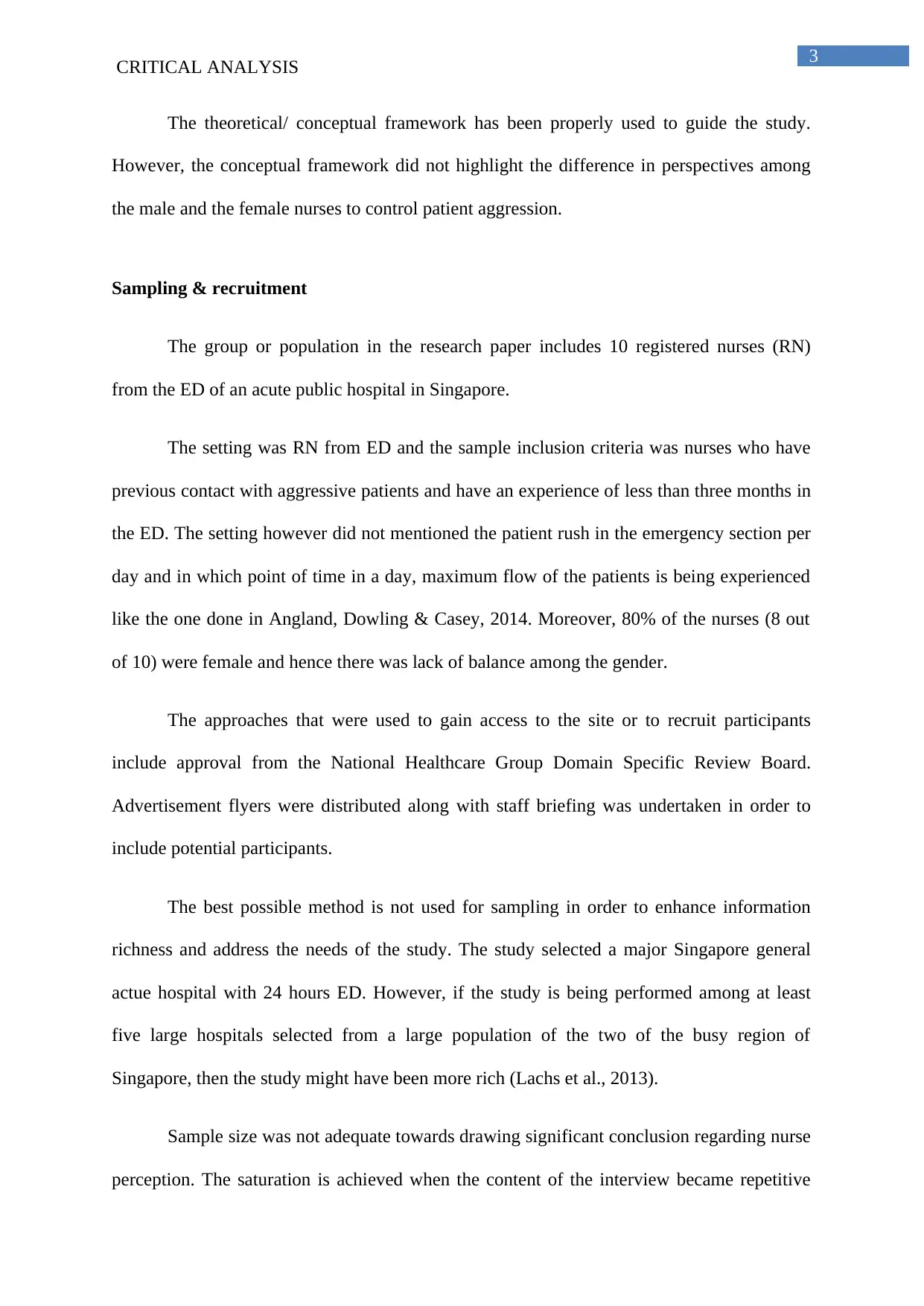
3
CRITICAL ANALYSIS
The theoretical/ conceptual framework has been properly used to guide the study.
However, the conceptual framework did not highlight the difference in perspectives among
the male and the female nurses to control patient aggression.
Sampling & recruitment
The group or population in the research paper includes 10 registered nurses (RN)
from the ED of an acute public hospital in Singapore.
The setting was RN from ED and the sample inclusion criteria was nurses who have
previous contact with aggressive patients and have an experience of less than three months in
the ED. The setting however did not mentioned the patient rush in the emergency section per
day and in which point of time in a day, maximum flow of the patients is being experienced
like the one done in Angland, Dowling & Casey, 2014. Moreover, 80% of the nurses (8 out
of 10) were female and hence there was lack of balance among the gender.
The approaches that were used to gain access to the site or to recruit participants
include approval from the National Healthcare Group Domain Specific Review Board.
Advertisement flyers were distributed along with staff briefing was undertaken in order to
include potential participants.
The best possible method is not used for sampling in order to enhance information
richness and address the needs of the study. The study selected a major Singapore general
actue hospital with 24 hours ED. However, if the study is being performed among at least
five large hospitals selected from a large population of the two of the busy region of
Singapore, then the study might have been more rich (Lachs et al., 2013).
Sample size was not adequate towards drawing significant conclusion regarding nurse
perception. The saturation is achieved when the content of the interview became repetitive
CRITICAL ANALYSIS
The theoretical/ conceptual framework has been properly used to guide the study.
However, the conceptual framework did not highlight the difference in perspectives among
the male and the female nurses to control patient aggression.
Sampling & recruitment
The group or population in the research paper includes 10 registered nurses (RN)
from the ED of an acute public hospital in Singapore.
The setting was RN from ED and the sample inclusion criteria was nurses who have
previous contact with aggressive patients and have an experience of less than three months in
the ED. The setting however did not mentioned the patient rush in the emergency section per
day and in which point of time in a day, maximum flow of the patients is being experienced
like the one done in Angland, Dowling & Casey, 2014. Moreover, 80% of the nurses (8 out
of 10) were female and hence there was lack of balance among the gender.
The approaches that were used to gain access to the site or to recruit participants
include approval from the National Healthcare Group Domain Specific Review Board.
Advertisement flyers were distributed along with staff briefing was undertaken in order to
include potential participants.
The best possible method is not used for sampling in order to enhance information
richness and address the needs of the study. The study selected a major Singapore general
actue hospital with 24 hours ED. However, if the study is being performed among at least
five large hospitals selected from a large population of the two of the busy region of
Singapore, then the study might have been more rich (Lachs et al., 2013).
Sample size was not adequate towards drawing significant conclusion regarding nurse
perception. The saturation is achieved when the content of the interview became repetitive
Paraphrase This Document
Need a fresh take? Get an instant paraphrase of this document with our AI Paraphraser
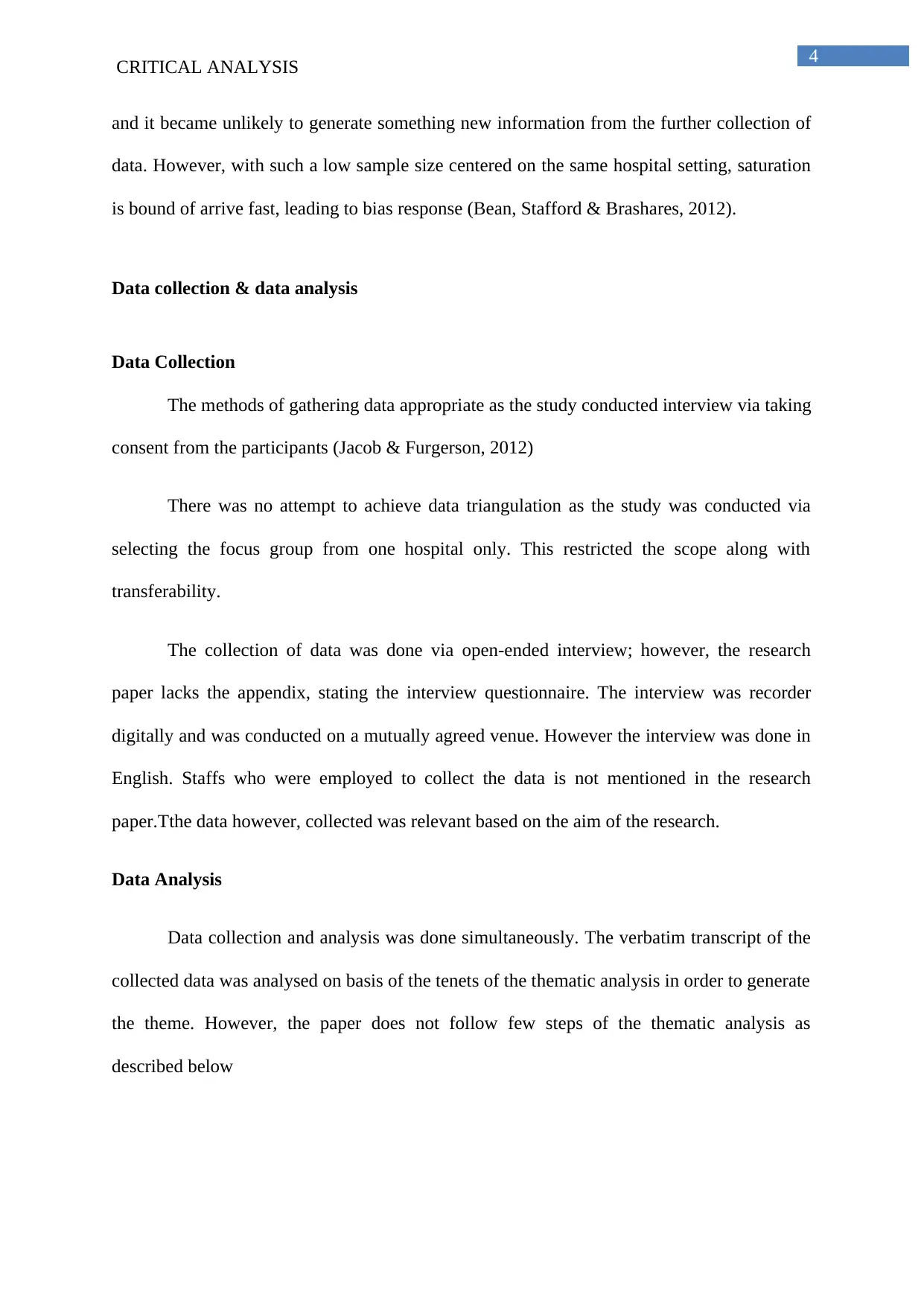
4
CRITICAL ANALYSIS
and it became unlikely to generate something new information from the further collection of
data. However, with such a low sample size centered on the same hospital setting, saturation
is bound of arrive fast, leading to bias response (Bean, Stafford & Brashares, 2012).
Data collection & data analysis
Data Collection
The methods of gathering data appropriate as the study conducted interview via taking
consent from the participants (Jacob & Furgerson, 2012)
There was no attempt to achieve data triangulation as the study was conducted via
selecting the focus group from one hospital only. This restricted the scope along with
transferability.
The collection of data was done via open-ended interview; however, the research
paper lacks the appendix, stating the interview questionnaire. The interview was recorder
digitally and was conducted on a mutually agreed venue. However the interview was done in
English. Staffs who were employed to collect the data is not mentioned in the research
paper.Tthe data however, collected was relevant based on the aim of the research.
Data Analysis
Data collection and analysis was done simultaneously. The verbatim transcript of the
collected data was analysed on basis of the tenets of the thematic analysis in order to generate
the theme. However, the paper does not follow few steps of the thematic analysis as
described below
CRITICAL ANALYSIS
and it became unlikely to generate something new information from the further collection of
data. However, with such a low sample size centered on the same hospital setting, saturation
is bound of arrive fast, leading to bias response (Bean, Stafford & Brashares, 2012).
Data collection & data analysis
Data Collection
The methods of gathering data appropriate as the study conducted interview via taking
consent from the participants (Jacob & Furgerson, 2012)
There was no attempt to achieve data triangulation as the study was conducted via
selecting the focus group from one hospital only. This restricted the scope along with
transferability.
The collection of data was done via open-ended interview; however, the research
paper lacks the appendix, stating the interview questionnaire. The interview was recorder
digitally and was conducted on a mutually agreed venue. However the interview was done in
English. Staffs who were employed to collect the data is not mentioned in the research
paper.Tthe data however, collected was relevant based on the aim of the research.
Data Analysis
Data collection and analysis was done simultaneously. The verbatim transcript of the
collected data was analysed on basis of the tenets of the thematic analysis in order to generate
the theme. However, the paper does not follow few steps of the thematic analysis as
described below
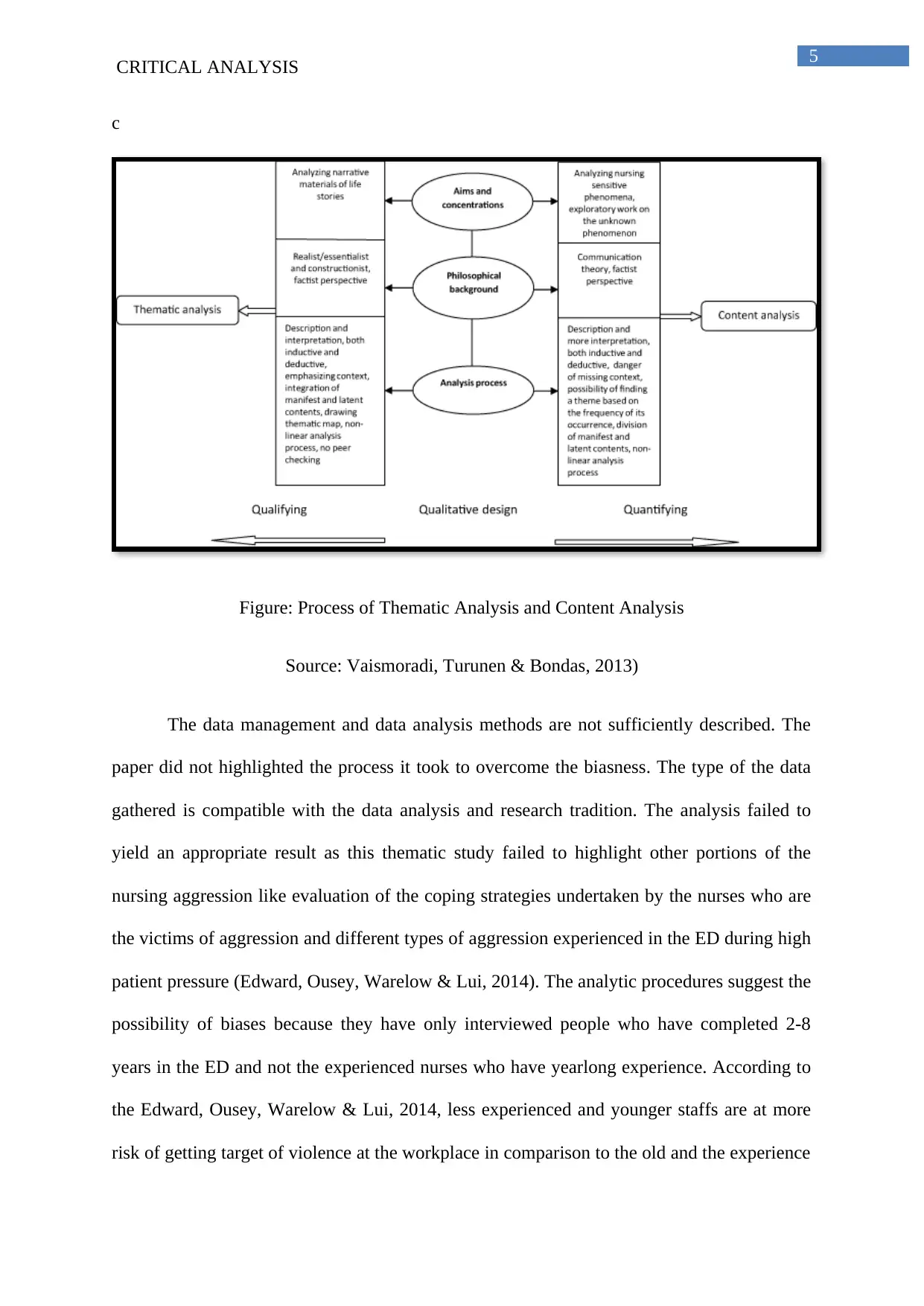
5
CRITICAL ANALYSIS
c
Figure: Process of Thematic Analysis and Content Analysis
Source: Vaismoradi, Turunen & Bondas, 2013)
The data management and data analysis methods are not sufficiently described. The
paper did not highlighted the process it took to overcome the biasness. The type of the data
gathered is compatible with the data analysis and research tradition. The analysis failed to
yield an appropriate result as this thematic study failed to highlight other portions of the
nursing aggression like evaluation of the coping strategies undertaken by the nurses who are
the victims of aggression and different types of aggression experienced in the ED during high
patient pressure (Edward, Ousey, Warelow & Lui, 2014). The analytic procedures suggest the
possibility of biases because they have only interviewed people who have completed 2-8
years in the ED and not the experienced nurses who have yearlong experience. According to
the Edward, Ousey, Warelow & Lui, 2014, less experienced and younger staffs are at more
risk of getting target of violence at the workplace in comparison to the old and the experience
CRITICAL ANALYSIS
c
Figure: Process of Thematic Analysis and Content Analysis
Source: Vaismoradi, Turunen & Bondas, 2013)
The data management and data analysis methods are not sufficiently described. The
paper did not highlighted the process it took to overcome the biasness. The type of the data
gathered is compatible with the data analysis and research tradition. The analysis failed to
yield an appropriate result as this thematic study failed to highlight other portions of the
nursing aggression like evaluation of the coping strategies undertaken by the nurses who are
the victims of aggression and different types of aggression experienced in the ED during high
patient pressure (Edward, Ousey, Warelow & Lui, 2014). The analytic procedures suggest the
possibility of biases because they have only interviewed people who have completed 2-8
years in the ED and not the experienced nurses who have yearlong experience. According to
the Edward, Ousey, Warelow & Lui, 2014, less experienced and younger staffs are at more
risk of getting target of violence at the workplace in comparison to the old and the experience
⊘ This is a preview!⊘
Do you want full access?
Subscribe today to unlock all pages.

Trusted by 1+ million students worldwide
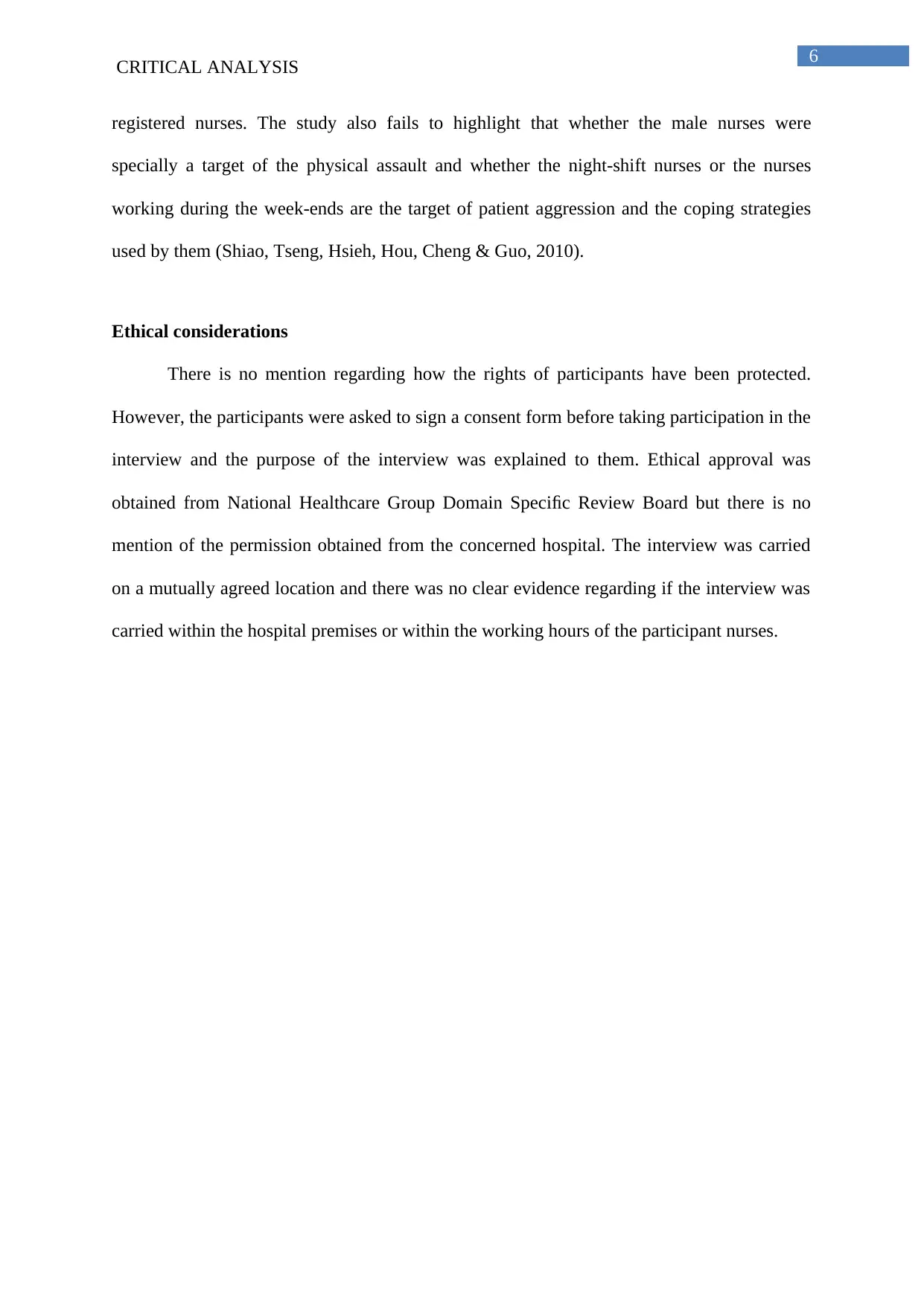
6
CRITICAL ANALYSIS
registered nurses. The study also fails to highlight that whether the male nurses were
specially a target of the physical assault and whether the night-shift nurses or the nurses
working during the week-ends are the target of patient aggression and the coping strategies
used by them (Shiao, Tseng, Hsieh, Hou, Cheng & Guo, 2010).
Ethical considerations
There is no mention regarding how the rights of participants have been protected.
However, the participants were asked to sign a consent form before taking participation in the
interview and the purpose of the interview was explained to them. Ethical approval was
obtained from National Healthcare Group Domain Specific Review Board but there is no
mention of the permission obtained from the concerned hospital. The interview was carried
on a mutually agreed location and there was no clear evidence regarding if the interview was
carried within the hospital premises or within the working hours of the participant nurses.
CRITICAL ANALYSIS
registered nurses. The study also fails to highlight that whether the male nurses were
specially a target of the physical assault and whether the night-shift nurses or the nurses
working during the week-ends are the target of patient aggression and the coping strategies
used by them (Shiao, Tseng, Hsieh, Hou, Cheng & Guo, 2010).
Ethical considerations
There is no mention regarding how the rights of participants have been protected.
However, the participants were asked to sign a consent form before taking participation in the
interview and the purpose of the interview was explained to them. Ethical approval was
obtained from National Healthcare Group Domain Specific Review Board but there is no
mention of the permission obtained from the concerned hospital. The interview was carried
on a mutually agreed location and there was no clear evidence regarding if the interview was
carried within the hospital premises or within the working hours of the participant nurses.
Paraphrase This Document
Need a fresh take? Get an instant paraphrase of this document with our AI Paraphraser
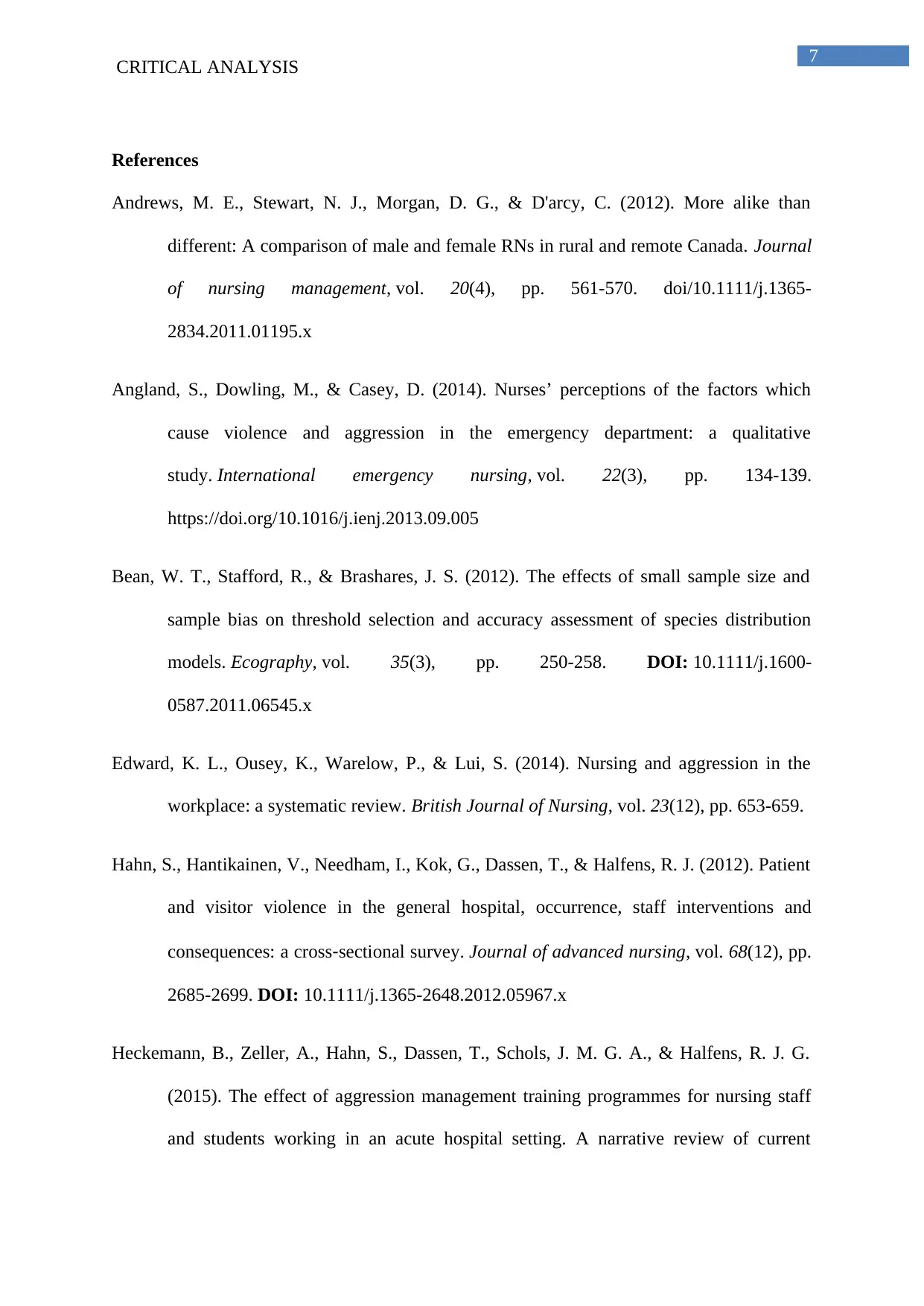
7
CRITICAL ANALYSIS
References
Andrews, M. E., Stewart, N. J., Morgan, D. G., & D'arcy, C. (2012). More alike than
different: A comparison of male and female RNs in rural and remote Canada. Journal
of nursing management, vol. 20(4), pp. 561-570. doi/10.1111/j.1365-
2834.2011.01195.x
Angland, S., Dowling, M., & Casey, D. (2014). Nurses’ perceptions of the factors which
cause violence and aggression in the emergency department: a qualitative
study. International emergency nursing, vol. 22(3), pp. 134-139.
https://doi.org/10.1016/j.ienj.2013.09.005
Bean, W. T., Stafford, R., & Brashares, J. S. (2012). The effects of small sample size and
sample bias on threshold selection and accuracy assessment of species distribution
models. Ecography, vol. 35(3), pp. 250-258. DOI: 10.1111/j.1600-
0587.2011.06545.x
Edward, K. L., Ousey, K., Warelow, P., & Lui, S. (2014). Nursing and aggression in the
workplace: a systematic review. British Journal of Nursing, vol. 23(12), pp. 653-659.
Hahn, S., Hantikainen, V., Needham, I., Kok, G., Dassen, T., & Halfens, R. J. (2012). Patient
and visitor violence in the general hospital, occurrence, staff interventions and
consequences: a cross‐sectional survey. Journal of advanced nursing, vol. 68(12), pp.
2685-2699. DOI: 10.1111/j.1365-2648.2012.05967.x
Heckemann, B., Zeller, A., Hahn, S., Dassen, T., Schols, J. M. G. A., & Halfens, R. J. G.
(2015). The effect of aggression management training programmes for nursing staff
and students working in an acute hospital setting. A narrative review of current
CRITICAL ANALYSIS
References
Andrews, M. E., Stewart, N. J., Morgan, D. G., & D'arcy, C. (2012). More alike than
different: A comparison of male and female RNs in rural and remote Canada. Journal
of nursing management, vol. 20(4), pp. 561-570. doi/10.1111/j.1365-
2834.2011.01195.x
Angland, S., Dowling, M., & Casey, D. (2014). Nurses’ perceptions of the factors which
cause violence and aggression in the emergency department: a qualitative
study. International emergency nursing, vol. 22(3), pp. 134-139.
https://doi.org/10.1016/j.ienj.2013.09.005
Bean, W. T., Stafford, R., & Brashares, J. S. (2012). The effects of small sample size and
sample bias on threshold selection and accuracy assessment of species distribution
models. Ecography, vol. 35(3), pp. 250-258. DOI: 10.1111/j.1600-
0587.2011.06545.x
Edward, K. L., Ousey, K., Warelow, P., & Lui, S. (2014). Nursing and aggression in the
workplace: a systematic review. British Journal of Nursing, vol. 23(12), pp. 653-659.
Hahn, S., Hantikainen, V., Needham, I., Kok, G., Dassen, T., & Halfens, R. J. (2012). Patient
and visitor violence in the general hospital, occurrence, staff interventions and
consequences: a cross‐sectional survey. Journal of advanced nursing, vol. 68(12), pp.
2685-2699. DOI: 10.1111/j.1365-2648.2012.05967.x
Heckemann, B., Zeller, A., Hahn, S., Dassen, T., Schols, J. M. G. A., & Halfens, R. J. G.
(2015). The effect of aggression management training programmes for nursing staff
and students working in an acute hospital setting. A narrative review of current
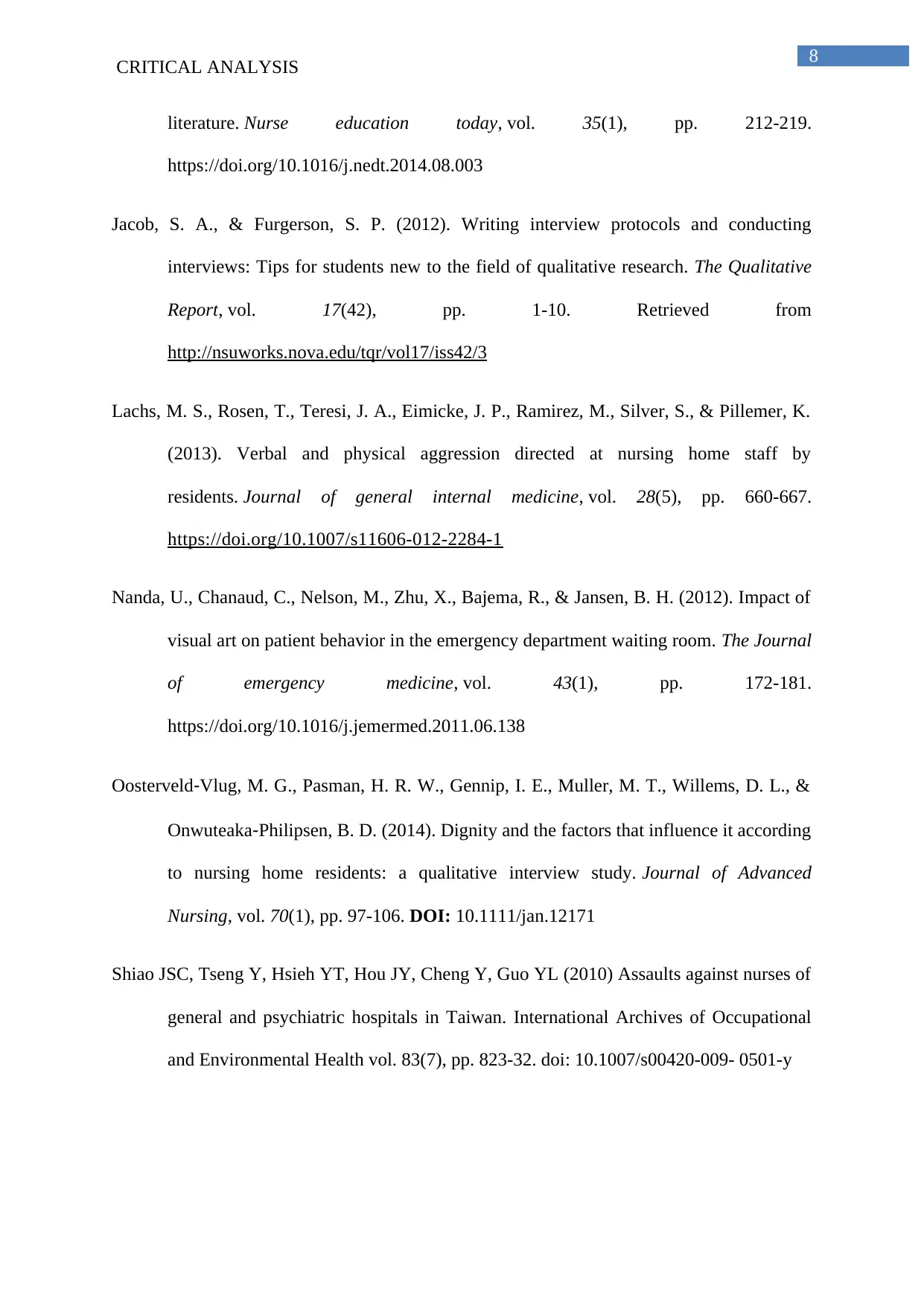
8
CRITICAL ANALYSIS
literature. Nurse education today, vol. 35(1), pp. 212-219.
https://doi.org/10.1016/j.nedt.2014.08.003
Jacob, S. A., & Furgerson, S. P. (2012). Writing interview protocols and conducting
interviews: Tips for students new to the field of qualitative research. The Qualitative
Report, vol. 17(42), pp. 1-10. Retrieved from
http://nsuworks.nova.edu/tqr/vol17/iss42/3
Lachs, M. S., Rosen, T., Teresi, J. A., Eimicke, J. P., Ramirez, M., Silver, S., & Pillemer, K.
(2013). Verbal and physical aggression directed at nursing home staff by
residents. Journal of general internal medicine, vol. 28(5), pp. 660-667.
https://doi.org/10.1007/s11606-012-2284-1
Nanda, U., Chanaud, C., Nelson, M., Zhu, X., Bajema, R., & Jansen, B. H. (2012). Impact of
visual art on patient behavior in the emergency department waiting room. The Journal
of emergency medicine, vol. 43(1), pp. 172-181.
https://doi.org/10.1016/j.jemermed.2011.06.138
Oosterveld‐Vlug, M. G., Pasman, H. R. W., Gennip, I. E., Muller, M. T., Willems, D. L., &
Onwuteaka‐Philipsen, B. D. (2014). Dignity and the factors that influence it according
to nursing home residents: a qualitative interview study. Journal of Advanced
Nursing, vol. 70(1), pp. 97-106. DOI: 10.1111/jan.12171
Shiao JSC, Tseng Y, Hsieh YT, Hou JY, Cheng Y, Guo YL (2010) Assaults against nurses of
general and psychiatric hospitals in Taiwan. International Archives of Occupational
and Environmental Health vol. 83(7), pp. 823-32. doi: 10.1007/s00420-009- 0501-y
CRITICAL ANALYSIS
literature. Nurse education today, vol. 35(1), pp. 212-219.
https://doi.org/10.1016/j.nedt.2014.08.003
Jacob, S. A., & Furgerson, S. P. (2012). Writing interview protocols and conducting
interviews: Tips for students new to the field of qualitative research. The Qualitative
Report, vol. 17(42), pp. 1-10. Retrieved from
http://nsuworks.nova.edu/tqr/vol17/iss42/3
Lachs, M. S., Rosen, T., Teresi, J. A., Eimicke, J. P., Ramirez, M., Silver, S., & Pillemer, K.
(2013). Verbal and physical aggression directed at nursing home staff by
residents. Journal of general internal medicine, vol. 28(5), pp. 660-667.
https://doi.org/10.1007/s11606-012-2284-1
Nanda, U., Chanaud, C., Nelson, M., Zhu, X., Bajema, R., & Jansen, B. H. (2012). Impact of
visual art on patient behavior in the emergency department waiting room. The Journal
of emergency medicine, vol. 43(1), pp. 172-181.
https://doi.org/10.1016/j.jemermed.2011.06.138
Oosterveld‐Vlug, M. G., Pasman, H. R. W., Gennip, I. E., Muller, M. T., Willems, D. L., &
Onwuteaka‐Philipsen, B. D. (2014). Dignity and the factors that influence it according
to nursing home residents: a qualitative interview study. Journal of Advanced
Nursing, vol. 70(1), pp. 97-106. DOI: 10.1111/jan.12171
Shiao JSC, Tseng Y, Hsieh YT, Hou JY, Cheng Y, Guo YL (2010) Assaults against nurses of
general and psychiatric hospitals in Taiwan. International Archives of Occupational
and Environmental Health vol. 83(7), pp. 823-32. doi: 10.1007/s00420-009- 0501-y
⊘ This is a preview!⊘
Do you want full access?
Subscribe today to unlock all pages.

Trusted by 1+ million students worldwide
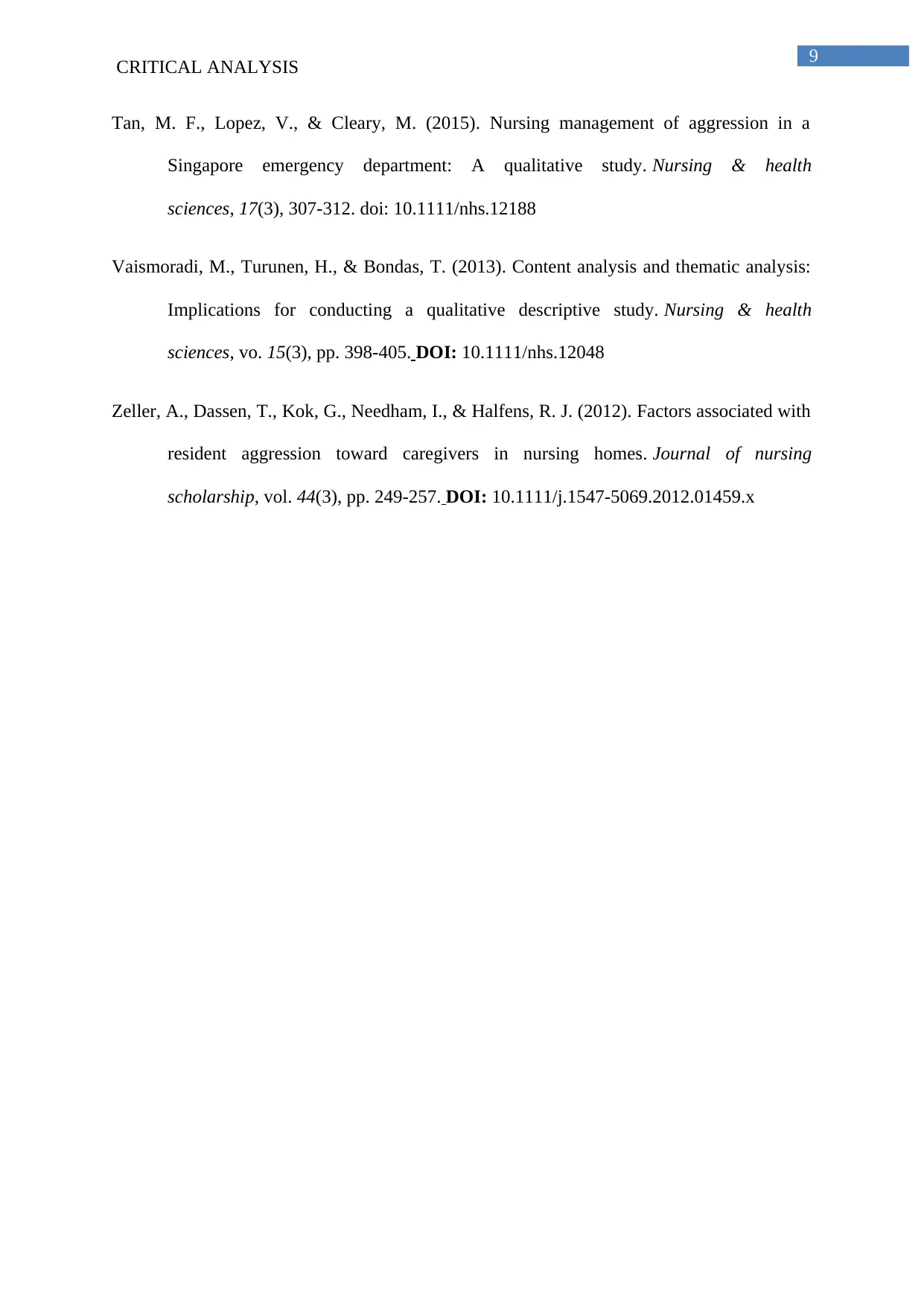
9
CRITICAL ANALYSIS
Tan, M. F., Lopez, V., & Cleary, M. (2015). Nursing management of aggression in a
Singapore emergency department: A qualitative study. Nursing & health
sciences, 17(3), 307-312. doi: 10.1111/nhs.12188
Vaismoradi, M., Turunen, H., & Bondas, T. (2013). Content analysis and thematic analysis:
Implications for conducting a qualitative descriptive study. Nursing & health
sciences, vo. 15(3), pp. 398-405. DOI: 10.1111/nhs.12048
Zeller, A., Dassen, T., Kok, G., Needham, I., & Halfens, R. J. (2012). Factors associated with
resident aggression toward caregivers in nursing homes. Journal of nursing
scholarship, vol. 44(3), pp. 249-257. DOI: 10.1111/j.1547-5069.2012.01459.x
CRITICAL ANALYSIS
Tan, M. F., Lopez, V., & Cleary, M. (2015). Nursing management of aggression in a
Singapore emergency department: A qualitative study. Nursing & health
sciences, 17(3), 307-312. doi: 10.1111/nhs.12188
Vaismoradi, M., Turunen, H., & Bondas, T. (2013). Content analysis and thematic analysis:
Implications for conducting a qualitative descriptive study. Nursing & health
sciences, vo. 15(3), pp. 398-405. DOI: 10.1111/nhs.12048
Zeller, A., Dassen, T., Kok, G., Needham, I., & Halfens, R. J. (2012). Factors associated with
resident aggression toward caregivers in nursing homes. Journal of nursing
scholarship, vol. 44(3), pp. 249-257. DOI: 10.1111/j.1547-5069.2012.01459.x
1 out of 10
Your All-in-One AI-Powered Toolkit for Academic Success.
+13062052269
info@desklib.com
Available 24*7 on WhatsApp / Email
![[object Object]](/_next/static/media/star-bottom.7253800d.svg)
Unlock your academic potential
Copyright © 2020–2025 A2Z Services. All Rights Reserved. Developed and managed by ZUCOL.


